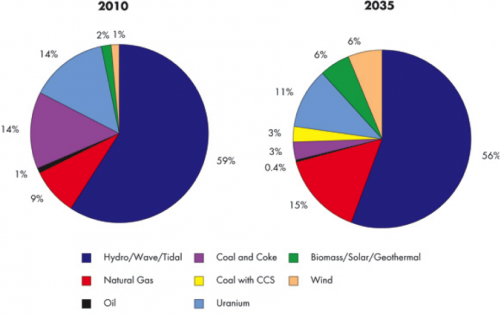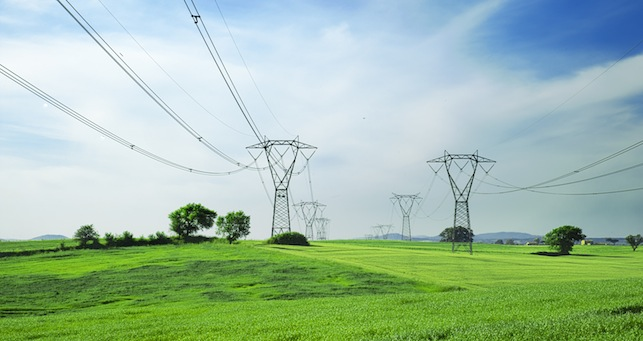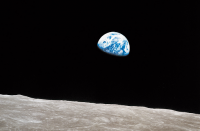The Canada of 2035 will be a very different place. We’ll be a nation of 43 million people; the GTA alone will balloon to more than nine million residents. It is hard to fathom the changes society will undergo in the next 22 years. Just think back to 1991 (if you’re old enough to remember it) for comparison.
The Canada of 2035 will be a very different place. We’ll be a nation of 43 million people; the GTA alone will balloon to more than nine million residents. It is hard to fathom the changes society will undergo in the next 22 years. Just think back to 1991 (if you’re old enough to remember it) for comparison. Continued growth in both population and energy consumption will fundamentally alter the national energy mix and the politics of our energy systems.
Looking ahead to 2035 is a useful endeavour: important infrastructure decisions made today will still be in place, and most readers of this blog will be living with the consequences. Twenty-two years is far enough away that we have a chance to change our trajectory, but not so far that we can afford to ignore it.
One of the best (and relatively unbiased) indications of the future is the International Energy Agency’s (IEA) World Energy Outlook. The IEA’s 2012 report made media headlines for its bold prediction of ‘sweeping transformations’ to North America’s energy systems. The report’s authors argue that transformation will be driven by three trends: massive expansion and continued dominance of the fossil fuel industry, renewables becoming a leading source of energy, and improvements to energy efficiency.

Projected changes to Canada’s energy generation mix. Source: National Energy Board.
The IEA postulates that oil and gas will continue to dominate in Canada, and that unconventional sources like shale gas, deep-water drilling and oil sands will turn North America into an oil exporter by 2035. Whether this is realistic from an environmental viewpoint, or a political viewpoint for that matter, is worth considering. Already in both Canada and the US there is mounting public opposition to shale gas spurred by recent documentaries and health concerns. Resistance to the Harper government’s push for pipelines from the oil sands is only increasing, and the Toronto Star reports that major projects (Line 9, Northern Gateway and Keystone XL) are all facing obstacles. While the oil and gas sector isn’t likely to disappear any time soon, the good old days of petrodollars flooding Alberta’s and Ottawa’s coffers are likely over as the United States moves towards self-sufficiency.
The good news is that renewable energy in the form of wind and solar is poised to become Canada’s second biggest power generator by 2035. The costs of renewable energy technologies are predicted to fall and government subsidies are expected to rise, helping to drive greener alternatives. The IEA notes that subsides for the oil and gas industry are still about six times higher than those for renewables, so governments will have to commit funds in the near future. (Ontario, for example, has been subsidizing wind and solar to a large extent). By 2035 there will also likely be stringent controls on carbon emissions to help drive renewables.
Another study by Royal Dutch Shell optimistically predicts that renewables could make up 30 to 40 per cent of global energy by 2060. Unfortunately, renewables are still facing a number of political hurdles. Ontario is often showcased as a green energy leader for having virtually eliminated coal generation and implementing the Green Energy Act. However the renewable energy market – faces serious logistical issues and is prone to changes in the political landscape. Anti-wind sentiment dominates the province’s rural areas, while the easy solution – offshore wind development – continues to face an illogical moratorium imposed by the provincial government with no end in sight.
Gains in energy efficiency are expected to help bridge the carbon gap between continued fossil fuel use and renewable adoption. By 2020 the prospect of keeping global warming at 2°C will hang in the balance. Increased efficiency and conservation will buy time as a new global climate change agreement is implemented and policy measures begin to take effect, but “two-thirds of the economically viable potential to improve energy efficiency will remain unrealised through to 2035,” according to the IEA. Canada has been characteristically inconsistent on this issue. For example, incandescent light bulbs were scheduled to be banned on January 1st, 2012 but both the Ontario and federal governments delayed the ban for another two years due to “consumer concerns.” While governments can regulate and provide guidance, the corporate sector has an opportunity to step up and provide environmental stewardship, utilizing programs like Energy-Star.
Other factors, including electric vehicle adoption and the building of decentralized ‘smart’ electricity grids will challenge Canada’s energy systems as never before. These new systems will need to be championed by the equivalent of a twenty-first century Adam Beck, founder of Ontario’s first hydroelectric power system. At any rate, the next two decades should be pretty interesting.
Dan is an environmental professional currently living in Toronto and working in the energy sector. His areas of interest include energy, transportation, corporate social responsibility and climate change policy. He completed a Masters of Environmental Applied Science and Management at Ryerson University in 2012.
Dan is an environmental professional currently living in Toronto. Dan has previously published in Municipal World and Environmental Science and Engineering. He specializes in energy, transportation, and climate change policy, corporate sustainability, and environmental planning and assessments. He recently completed a Masters of Environmental Applied Science and Management at Ryerson University and has a Bachelors' degree in Environment and Business from the University of Waterloo.













